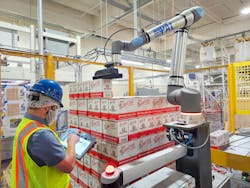Universal Robots Increases UR20 and UR30 Payload Capacity
Oct. 7, 2024
2 min read
We’re all very familiar with new capabilities being delivered to all kinds of equipment—from laser jet printers to automobiles—via software and firmware updates. You can now add robots to this list of equipment whose performance capabilities are being enhanced in this manner.
In this case, the update comes from Universal Robots to increase the payload capacity on its high-payload cobots, the UR20 and UR30, raising their total payload to 25kg and 35 kg, respectively, including the end-effector. This added payload capacity is being delivered to users at no additional cost.
According to Universal Robots (UR), the increased payload can be unlocked by updating UR’s PolyScope software to version 5.19 or later.
How the update works
“A lot of the advanced capabilities of robots are often software-defined, particularly Universal Robots, where everything is so tightly integrated,” said Anders Billesø Beck, UR's vice president of technology. “Every number you see on a Universal Robots data sheet is just as much driven by our software and controls as by the actual mechanical performance.”
To learn more about software-defined automation, see this column by G Brooks-Zak of system integrator Outlier Automation.
Beck explained further that the role of control software in modern robotic systems is to channel power and torque as needed while ensuring longevity of the hardware. He added that this software update has been targeted to “maximize performance in the specific use case where the item [being lifted] hangs under the robot's tool flange. Here, we have found mechanical surplus and optimized the software to leverage this capacity, providing a good user experience around it,” he said.
This extra capacity has been added in response to interest from UR users in the packaging, palletizing and handling industry who are “seeking to move closer to the limits and lift heavier loads,” said Beck. “As soon as the parts [being lifted] become bigger and heavier, it [the robot arm] has more momentum, but we really spent time optimizing for this. We will be delivering at least the same performance that we were under the previous payload condition.”
About the Author
David Greenfield, editor in chief
Editor in Chief
David Greenfield joined Automation World in June 2011. Bringing a wealth of industry knowledge and media experience to his position, David’s contributions can be found in AW’s print and online editions and custom projects. Earlier in his career, David was Editorial Director of Design News at UBM Electronics, and prior to joining UBM, he was Editorial Director of Control Engineering at Reed Business Information, where he also worked on Manufacturing Business Technology as Publisher.
Sign up for our eNewsletters
Get the latest news and updates

